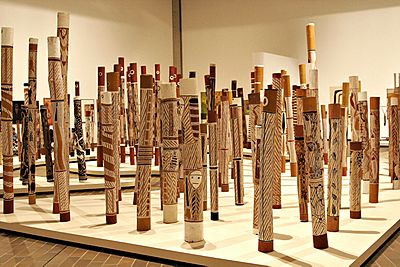Aboriginal Memorial facts for kids
Quick facts for kids The Aboriginal Memorial |
|
|---|---|
 |
|
| Artist | Artists of Ramingining, central Arnhem Land, Northern Territory, Australia |
| Year | 1987 |
| Type | Sculpture installation: natural pigments on wood |
| Location | National Gallery of Australia, Canberra |
The Aboriginal Memorial is a work of contemporary Indigenous Australian art from the late 1980s, and comprises 200 decorated hollow log coffins (also known as memorial poles, dupun, ḻarrakitj and other terms). It was conceived by Djon (John) Mundine in 1987–88 and realised by 43 artists from Ramingining and neighbouring communities of Central Arnhem Land, in the Northern Territory. Artists who participated in its creation included David Malangi and George Milpurrurru.
The work was created to coincide with the Australian Bicentenary and commemorates those Indigenous Australians who died as a result of European settlement. It was acquired by the National Gallery of Australia, where it is on permanent display. Its first exhibition was at the Sydney Biennale in 1988, and it was the centrepiece of an exhibition of Indigenous art at Russia's Hermitage Museum in 2000.
Creation
In 1988, Australia marked 200 years since its first official white settlement, established by Captain Arthur Phillip on Sydney Harbour in 1788. While some Indigenous Australians protested the event, and referred to the occasion as Invasion Day rather than Australia Day, a group of Indigenous artists from Ramingining in the Northern Territory decided to create an artwork to mark the anniversary. The project was initiated by Djon Mundine, an Indigenous art advisor and curator, who was working at Ramingining prior to the Bicentenary. A small group of artists including David Malangi, Paddy Dhathangu, George Milpurrurru and Jimmy Wululu decided the form of the project, but ultimately 43 artists from the region contributed pieces to the Memorial.
The work takes the form of 200 hollow log coffins, known as dupun: the number was chosen to mark the years of European settlement. Such coffins are a form of funerary art and are used throughout the Arnhem Land region for reburial ceremonies. The items displayed in Aboriginal Memorial, however, were created for the purpose of the artwork and have not at any stage contained human remains, nor been used in reburial ceremonies. The work was intended "to commemorate the thousands of Aboriginal people who had perished in the course of European settlement, and for whom it has not been possible to conduct appropriate mortuary rites". The intention behind the work drew attention in 2005 when Melbourne newspaper The Age ran an editorial asking whether it might be appropriate to commemorate Aboriginal resistance to white settlement at the Australian War Memorial, and to move the Aboriginal Memorial to that location as part of that commemoration.
Log coffins are made from trees that have been naturally hollowed out by termites. They are cut, cleaned and then painted with natural pigments during a ceremonial camp. The Aboriginal Memorial decorations reflect traditional clan designs and significant dreamings for which the artists had responsibility.
See also
 In Spanish: Monumento conmemorativo aborigen para niños
In Spanish: Monumento conmemorativo aborigen para niños

